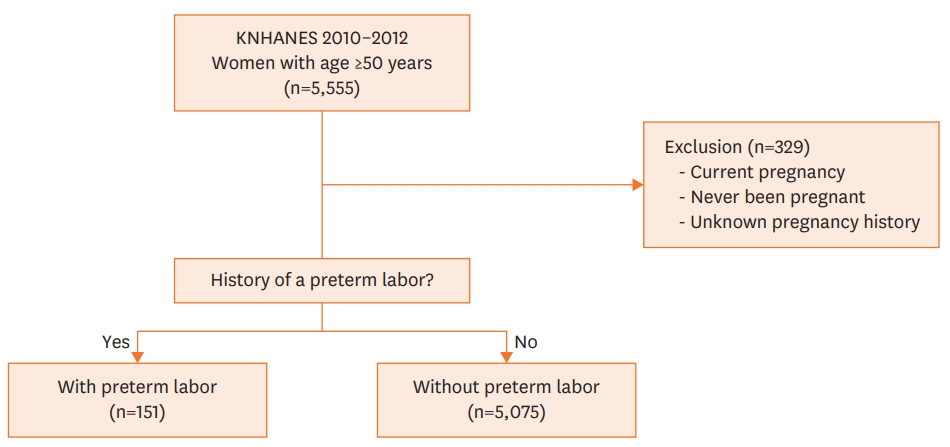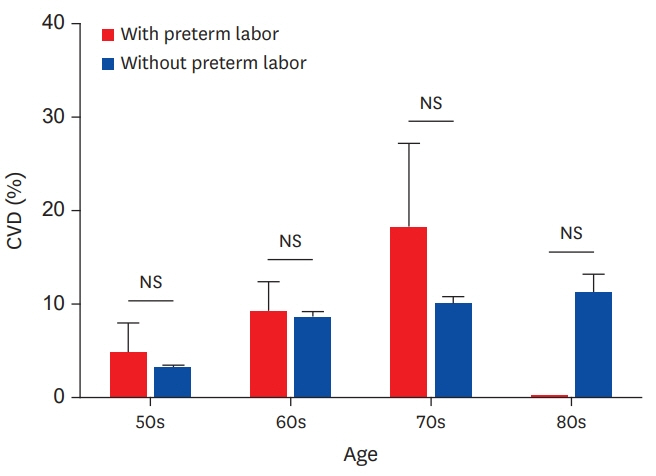Cardiovasc Prev Pharmacother.
2019 Oct;1(2):71-78. 10.36011/cpp.2019.1.e10.
Preterm Labor and Later Maternal Cardiovascular Disease in General Population: Doubtful Relationship with Atherosclerosis
- Affiliations
-
- 1Department of Cardiovascular Medicine, Incheon St. Mary's Hospital, College of Medicine, The Catholic University of Korea, Seoul, Korea
- 2Department of Cardiovascular Medicine, Cardiovascular Center, Seoul St. Mary's Hospital, College of Medicine, The Catholic University of Korea, Seoul, Korea
- 3Department of Preventive Medicine, College of Medicine, The Catholic University of Korea, Seoul, Korea
- 4Clinical Research Coordinating Center of Catholic Medical Center, The Catholic University of Korea, Seoul, Korea
- KMID: 2536966
- DOI: http://doi.org/10.36011/cpp.2019.1.e10
Abstract
- Background
The maternal cardiovascular system experiences an enormous challenge during pregnancy. A history of preterm labor suggestive of dysfunctional pregnancy might be associated with the maternal later life chronic cardiovascular disease (CVD). We evaluated the association between preterm labor and the late development of maternal atherosclerotic CVD using the national database of general population.
Methods
Data for 5,226 postmenopausal women aged ≥50 years were analyzed from the Korean National Health and Nutrition Examination Survey V, which had conducted from 2010 to 2012.
Results
The numbers of preterm labor and CVD (stroke, myocardial infarction, or angina pectoris) were 151 (3.0±0.3%) and 367 (6.6±0.4%), respectively. In a multivariate analysis, CVD was independently associated with age (odds ratio [OR], 1.9; 95% confidence interval [CI], 1.8–2.0), the presence of hypertension (OR, 1.9; 95% CI,1.5–2.3), diabetes (OR, 2.3; 95% CI, 1.8–2.9), chronic kidney disease (OR, 1.8; 95% CI, 1.4–2.2) and low high-density lipoprotein cholesterol concentration (OR, 0.8; 95% CI, 0.7–0.9) were independently associated with CVD. A history of preterm labor was not associated with CVD (OR, 1.5; 95% CI, 0.6–3.8).
Conclusions
There was no significant association between preterm labor and atherosclerotic CVD in general population. A history of preterm labor is not likely to be a risk factor for later CVD in women.
Keyword
Figure
Reference
-
1. Mosca L, Benjamin EJ, Berra K, Bezanson JL, Dolor RJ, Lloyd-Jones DM, Newby LK, Piña IL, Roger VL, Shaw LJ, Zhao D, Beckie TM, Bushnell C, D'Armiento J, Kris-Etherton PM, Fang J, Ganiats TG, Gomes AS, Gracia CR, Haan CK, Jackson EA, Judelson DR, Kelepouris E, Lavie CJ, Moore A, Nussmeier NA, Ofili E, Oparil S, Ouyang P, Pinn VW, Sherif K, Smith SC Jr, Sopko G, Chandra-Strobos N, Urbina EM, Vaccarino V, Wenger NK. Effectiveness-based guidelines for the prevention of cardiovascular disease in women--2011 update: a guideline from the American Heart Association. Circulation. 2011; 123:1243–62.
Article2. Jeong YA, Jeong MH, Jeong HC, Ahn Y, Kim YJ, Kim CJ; Cho MCKorea Acute Myocardial Infarction Registry (KAMIR) Investigators. Impact of smoking on clinical outcomes in female patients with acute myocardial infarction. Korean Circ J. 2015; 45:22–7.
Article3. Sattar N, Greer IA. Pregnancy complications and maternal cardiovascular risk: opportunities for intervention and screening? BMJ. 2002; 325:157–60.
Article4. Saade GR. Pregnancy as a window to future health. Obstet Gynecol. 2009; 114:958–60.
Article5. Rich-Edwards JW. Reproductive health as a sentinel of chronic disease in women. Womens Health (Lond). 2009; 5:101–5.
Article6. Mehta PK, Minissian M, Bairey Merz CN. Adverse pregnancy outcomes and cardiovascular risk factor management. Semin Perinatol. 2015; 39:268–75.
Article7. Mongraw-Chaffin ML, Cirillo PM, Cohn BA. Preeclampsia and cardiovascular disease death: prospective evidence from the child health and development studies cohort. Hypertension. 2010; 56:166–71.8. Davey Smith G, Hart C, Ferrell C, Upton M, Hole D, Hawthorne V, Watt G. Birth weight of offspring and mortality in the Renfrew and Paisley study: prospective observational study. BMJ. 1997; 315:1189–93.
Article9. Smith GD, Harding S, Rosato M. Relation between infants' birth weight and mothers' mortality: prospective observational study. BMJ. 2000; 320:839–40.
Article10. Smith GD, Whitley E, Gissler M, Hemminki E. Birth dimensions of offspring, premature birth, and the mortality of mothers. Lancet. 2000; 356:2066–7.
Article11. Smith GC, Pell JP, Walsh D. Pregnancy complications and maternal risk of ischaemic heart disease: a retrospective cohort study of 129,290 births. Lancet. 2001; 357:2002–6.
Article12. Smith GD, Sterne J, Tynelius P, Lawlor DA, Rasmussen F. Birth weight of offspring and subsequent cardiovascular mortality of the parents. Epidemiology. 2005; 16:563–9.
Article13. Manor O, Koupil I. Birth weight of infants and mortality in their parents and grandparents: the Uppsala Birth Cohort Study. Int J Epidemiol. 2010; 39:1264–76.
Article14. Lykke JA, Langhoff-Roos J, Lockwood CJ, Triche EW, Paidas MJ. Mortality of mothers from cardiovascular and non-cardiovascular causes following pregnancy complications in first delivery. Paediatr Perinat Epidemiol. 2010; 24:323–30.
Article15. Hastie CE, Smith GC, Mackay DF, Pell JP. Maternal risk of ischaemic heart disease following elective and spontaneous pre-term delivery: retrospective cohort study of 750 350 singleton pregnancies. Int J Epidemiol. 2011; 40:914–9.
Article16. Bonamy AK, Parikh NI, Cnattingius S, Ludvigsson JF, Ingelsson E. Birth characteristics and subsequent risks of maternal cardiovascular disease: effects of gestational age and fetal growth. Circulation. 2011; 124:2839–46.
Article17. Rich-Edwards JW, Fraser A, Lawlor DA, Catov JM. Pregnancy characteristics and women's future cardiovascular health: an underused opportunity to improve women's health? Epidemiol Rev. 2014; 36:57–70.
Article18. Bohrer J, Ehrenthal DB. Other adverse pregnancy outcomes and future chronic disease. Semin Perinatol. 2015; 39:259–63.
Article19. Kweon S, Kim Y, Jang MJ, Kim Y, Kim K, Choi S, Chun C, Khang YH, Oh K. Data resource profile: the Korea National Health and Nutrition Examination Survey (KNHANES). Int J Epidemiol. 2014; 43:69–77.
Article20. Korea Centers for Disease Control and Prevention. Korea National Health and Nutrition Examination Survey [Internet]. Cheongju: Korea Centers for Disease Control and Prevention;2016. [cited 2016 July 10]. Available from http://knhanes.cdc.go.kr.21. Levey AS, Stevens LA, Schmid CH, Zhang YL, Castro AF 3rd, Feldman HI, Kusek JW, Eggers P, Van Lente F, Greene T; Coresh JCKD-EPI (Chronic Kidney Disease Epidemiology Collaboration). A new equation to estimate glomerular filtration rate. Ann Intern Med. 2009; 150:604–12.
Article22. Friedewald WT, Levy RI, Fredrickson DS. Estimation of the concentration of low-density lipoprotein cholesterol in plasma, without use of the preparative ultracentrifuge. Clin Chem. 1972; 18:499–502.
Article23. Steegers EA, von Dadelszen P, Duvekot JJ, Pijnenborg R. Pre-eclampsia. Lancet. 2010; 376:631–44.
Article24. Friedlander Y, Paltiel O, Manor O, Deutsch L, Yanetz R, Calderon-Margalit R, Siscovick DS, Harlap S. Birthweight of offspring and mortality of parents: the Jerusalem perinatal study cohort. Ann Epidemiol. 2007; 17:914–22.
Article
- Full Text Links
- Actions
-
Cited
- CITED
-
- Close
- Share
- Similar articles
-
- Relationship Between Maternal Fetal Attachment and State Anxiety of Pregnant Women in the Preterm Labor
- Use of progesterone as a preventive medicine and nifedipine as a treatment of preterm labor
- Maternal serum highly sensitive C-reactive protein as a predictive marker of tocolytic success in preterm labor patient
- Does a preterm labor-assessment algorithm improve preterm labor-related knowledge, clinical practice confidence, and educational satisfaction?: a quasi-experimental study
- Efficacy of Maternal Serum Corticotropin Releasing Factor Levels in Diagnosis of Pregnancies Complicated by Preterm Labor



